

Granted, this free printable would be over 30 yards if you were to lay it out and no one I know has that much space available, but by using loose-leaf paper, we can hang up sections at a time as we’re learning about them.Īnother feature which I thought might be useful is to divide up the timeline by continent. I liked the idea of having a timeline that could be viewed all at once. The sheets being vertical also is a problem if you wanted the sheets to make one large, consecutive line on the wall.

Second, the problem with using a bound book (which was also an issue in other online world history timelines I found) is that there is no way to lay it all out and look at it at once.

I didn’t like the idea of putting the information on an arbitrary line when the event might only be known within 100 years or so. First, I didn’t want there to be lined divisions, because so many of the dates in ancient history are approximate. For example, in the Book of Centuries, the pages are vertical and frequently the books are bound (like a composition book where each line represents a 5 year period). However, I had small issues with everything I found available. Since learning about the Charlotte Mason book of centuries, I’ve seen blank timelines sold or as part of homeschooling programs. Since there is such little space and this book needs to last about a decade, the child has to be very discriminating about what they actually put in their book. Each century of human history is weighted equally with one page for writing and one page for pictures. If one follows those guidelines, each child has their own “Book of Centuries” that they keep throughout their whole education (starting maybe around 4th grade). I first heard about the concept of a blank world history timeline in the book More Charlotte Mason Education.


 0 kommentar(er)
0 kommentar(er)
